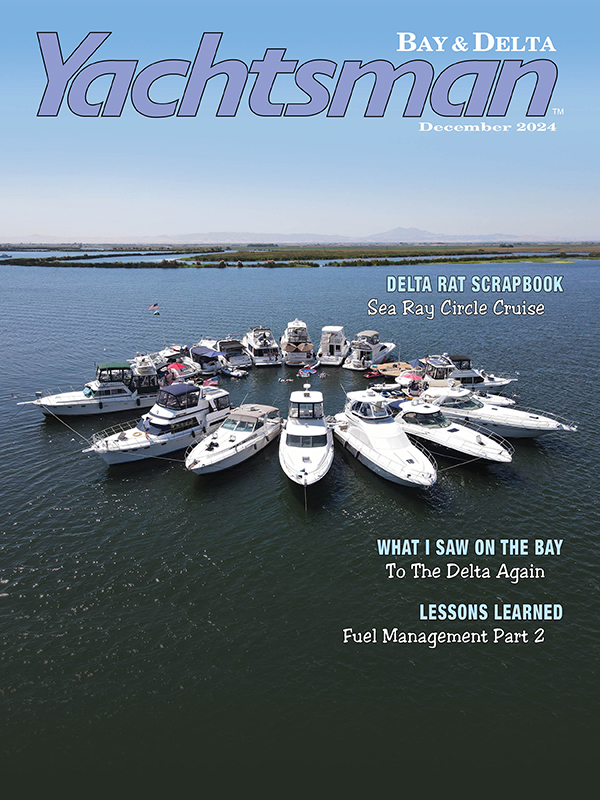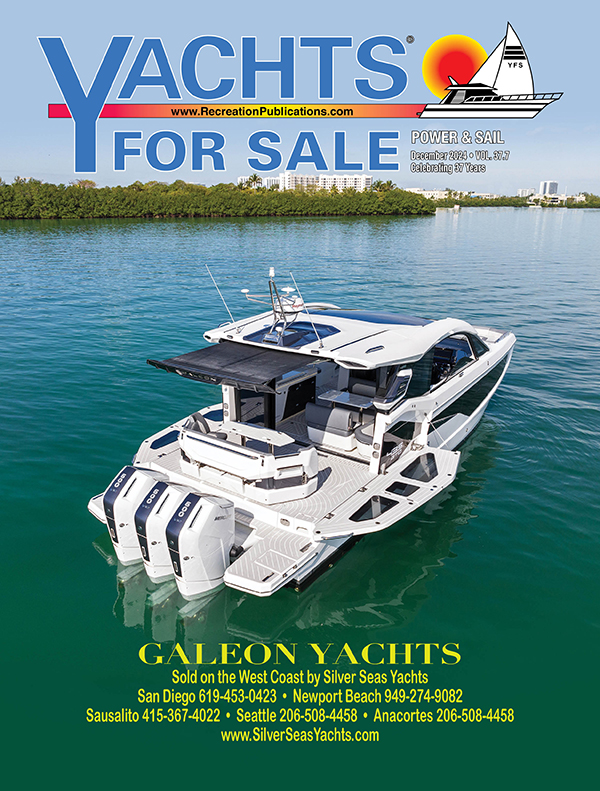Lessons Learned – by Pat Carson

Personal Flotation Devices – What’s Old Is New And What’s Different Is The Same
My last article on personal flotation devices was published in the Bay & Delta Yachtsman in Oct 2015 and I ended the piece with this paragraph: “The Coast Guard is working with the PFD community to revise the classification and labeling of PFDs. When completed, this information will be updated and hopefully be somewhat easier to understand. Meanwhile, spending a few minutes to understand the many options available to find a PFD that you’re willing to wear could mean the difference between life and death for you or a loved one. I hope that if you get anything out of this article it is to think safe. “There is always time for safety!”
Well, that day was last year, and I am a bit behind but hopefully not too late with the new information.
First Some Statistics
According to the U.S. Coast Guard national boating accident statistics for 2023, the Coast Guard counted 3,844 accidents that involved 564 deaths, 2,126 injuries and approximately $63 million of damage to property as a result of recreational boating accidents. The fatality rate was 5.2 deaths per 100,000 registered recreational vessels, and this represents a 5.6% decrease from 2022’s fatality rate of 5.6 deaths per 100,000 registered recreational vessels. Where the cause of death was known, 75% of fatal boating accident victims drowned. Of those drowning victims that reported use or nonuse of a life jacket, 87% were not wearing a life jacket. Where the instruction of the operator was known, 75% of deaths occurred on boats where the operator had received no boating safety instruction. Operator inattention, improper lookout, operator inexperience, excessive speed and alcohol use rank as the top five primary contributing factors in accidents. Alcohol use is the leading known contributing factor in fatal boating accidents; where the primary cause was known, it was listed as the leading factor in 17% of deaths. While there were no specific numbers provided for children and teens in the 2023 data, the 2022 data noted that 54 of the drowning victims and 459 of the injured were under 19 years old.
The 11.55 million recreational vessels registered in the United States in 2023 represent a 4.7% decrease from 2022 when 11.9 million recreational vessels were registered. Don’t you just love statistics? I hope these got your attention.
Personal Flotation Devices – Old Vs. New
In 2014, the U.S. Coast Guard removed the “Type” codes from the Code of Federal Regulations. As you may recall, life jackets and personal flotation devices had been referred to as Type I, II, III, IV and V, each of which corresponded to a certain performance or designated use. Going forward, these devices will be referred to as either “throwable” or “wearable” and have a performance category indicated by an icon. New life jackets that are brought to the market will feature these new labels. However, it will take many years for the older style labels to be completely phased out and you are likely to see both styles in stores, on boats and in use for many years to come. Any life jacket with the old-style label that is still serviceable and in overall good condition, as long as it is Coast Guard approved, will continue to meet the United States regulatory requirements.
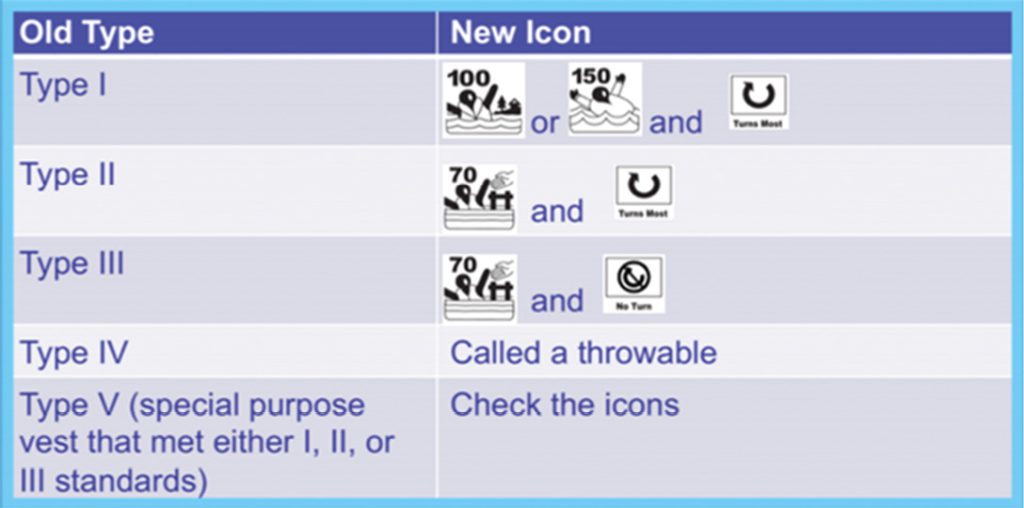
The old system of categorizing life jackets in five classes, Type I to Type V, worked well in the United States, however the systems used in Canada and Europe are quite different and for most U.S. boaters difficult to understand. Fast forward to today and the United States Coast Guard and manufacturers of personal flotation devices have harmonized the regulations and standards with the rest of the world.
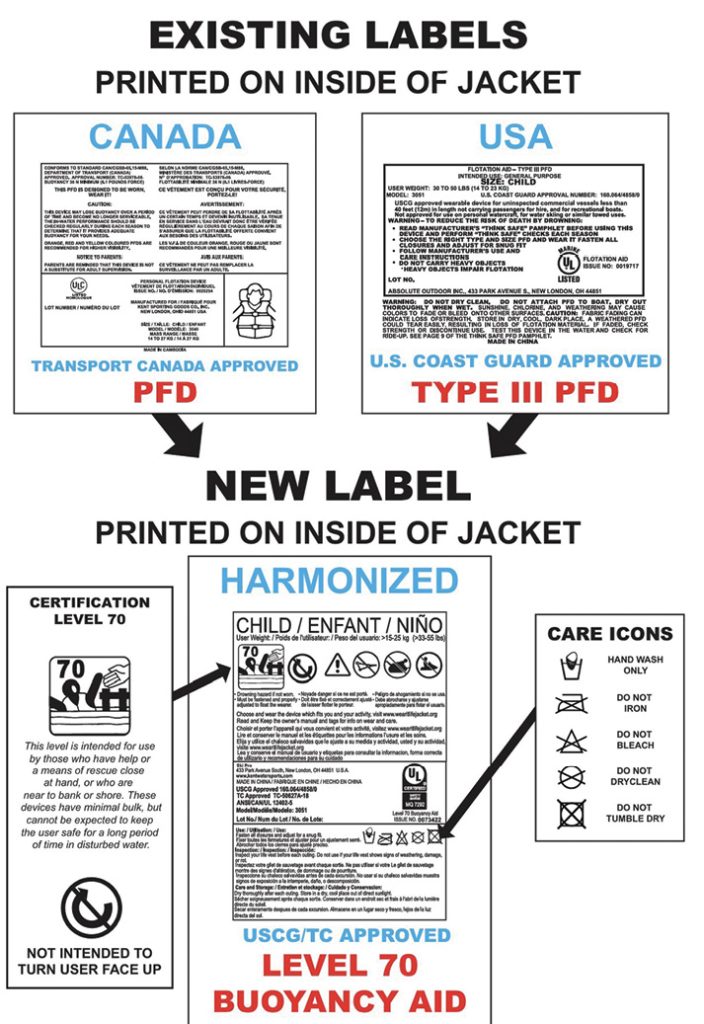
The new labeling system is simplified and much easier to understand as it clarifies the activities each jacket is designed for (or not designed for) and the amount of buoyancy it provides. The wearable life jackets are divided into five different numerical buoyancy categories: 50, 70, 100, 150 and 275 Newtons. A Newton is unit of measurement being used for measurement of buoyancy with the higher numbers providing the most flotation. We can easily convert Newton to pounds for easier understanding. Ten Newtons is equivalent to one kilogram and one kilogram is equal to 2.2 pounds. So, a PFD with 100 Newtons of buoyancy would be the same as 22 pounds.

The curved arrow indicates the turning ability of the life jacket. Turning ability is whether or not a life jacket is capable or designed to turn an unconscious person face up, unassisted. A Level 70 life jacket will not turn a person right side up, that’s what the curved arrow with a slash through it indicates. If there is no slash, it will turn most wearers face up. The higher the level number the more turning ability. The next thing you’ll notice are warnings and exclusions. There are icons with activities and a slash through it. These symbols indicate activities that the use of this jacket is not suitable for.
Top ten Features and Goals of the New Life Jacket Labels:
- 1. Performance summary graphic
- 2. Activity appropriateness icons
- 3. Legal requirements specified
- 4. Reduce language barriers
- 5. More universal acceptance
- 6. Harmony with other countries
- 7. Approval status clearly noted
- 8. Third party testing verification
- 9. Manufacturer contact information
- 10. Care and cleaning instructions
- In general, the intent of the new labels is to help users select and care for the appropriate life jacket for the activity in which they are participating. The labels have fewer words and more easily understood icons.
The new labeling system relies more on icons and less on descriptive wording. The older PFDs and flotation aids labeled with “TYPE” will still meet regulatory requirement until they are no longer serviceable. Fun fact and a word of caution, for those planning to take their boat to Canada, the Canadian Coast Guard does not recognize a PFD that is stamped with only a USCG approval. They must have the CCG or international approval marking. Ask me how I know this.
The wearable PFDs are now divided into five buoyancy categories: 50, 70, 100, 150 and 275 Newtons, however a level 50 flotation aid is not approved for carriage in the United States. Boaters will need to have a minimum Level 70 flotation aid to be compliant with the USCG requirements.
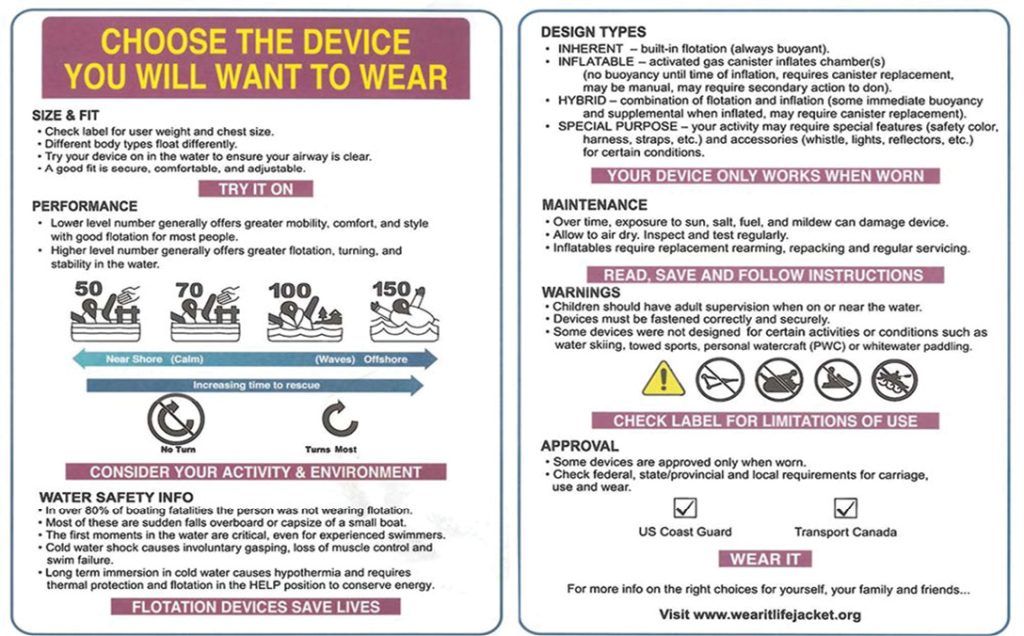
Choose the level of buoyancy for the type of activity. The curved arrow indicates that it is likely to turn an unconscious wearer face up in the water.
The new five level performance PFD labeling system is broken down by buoyancy.
Level 50 Buoyancy Aid is not recommended for weak or non-swimmers and has no self-turning ability, although it provides a minimum of 5kg of buoyancy. Buoyancy aids at Level 50 are recommended for use by those who are competent swimmers and who are near to land, or who have help close at hand. However, they do not have sufficient buoyancy to protect a person who is unable to help themselves. They are not designed to turn a person from a face-down position in the water and should not be used in any other circumstances. As mentioned earlier, a Level 50 Flotation Aid is not to be used on board your boat and does not meet the USCG requirements for PFD Carriage.

Level 70 buoyancy aids are equivalent to the old Types II and III PFDs which were commonly worn by recreational boaters and provides a minimum of 7kg of buoyancy per lifejacket. These flotation aids are intended for use by those who have a means of rescue close at hand, or who are near to a bank or shore. These devices have minimal bulk but cannot be expected to keep the user safe for a long period of time in rough water. Currently, the new, harmonized level 70 standard and labels only impact “legacy” type III life jackets for the U.S. and “legacy” PFDs for Canada. For U.S. approvals, Type I, Type II, Work Vests and Inflatable Life Jackets are NOT a part of the current harmonized standard. In Canada, Life Jacket Devices are NOT yet covered either. These are all planned for future development, but a timeline for conversion has not been established.
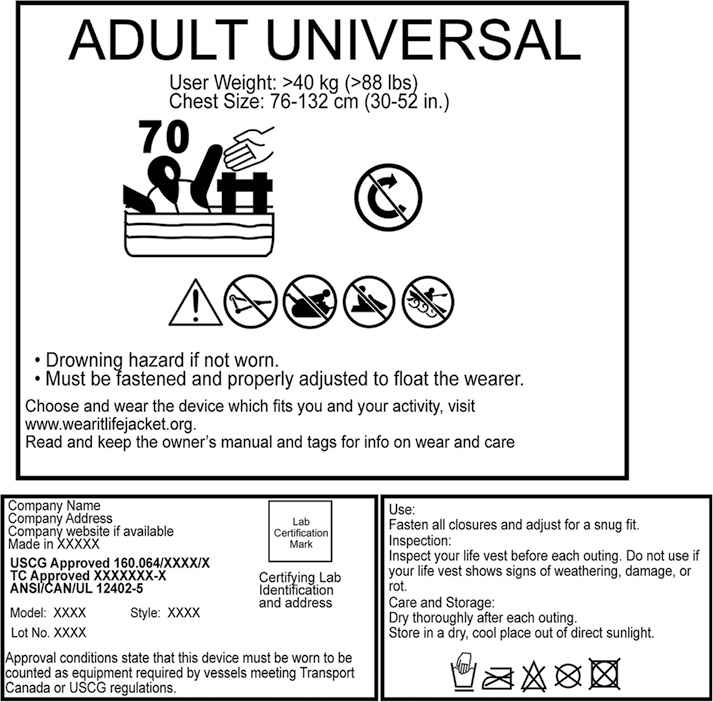
The level 100 Life Jacket is a high flotation PFD that has some self-turning ability but not in all instances. With a minimum of 10kg of buoyancy per lifejacket, this level of life jacket is intended for use in sheltered and calm waters. Level 100 does not have sufficient buoyancy to protect a person in rough waters and it will not turn the wearer so that they are safe. This level is intended for those who may have to wait for rescue but are likely to do so in sheltered water. The device should not be used in rough conditions.
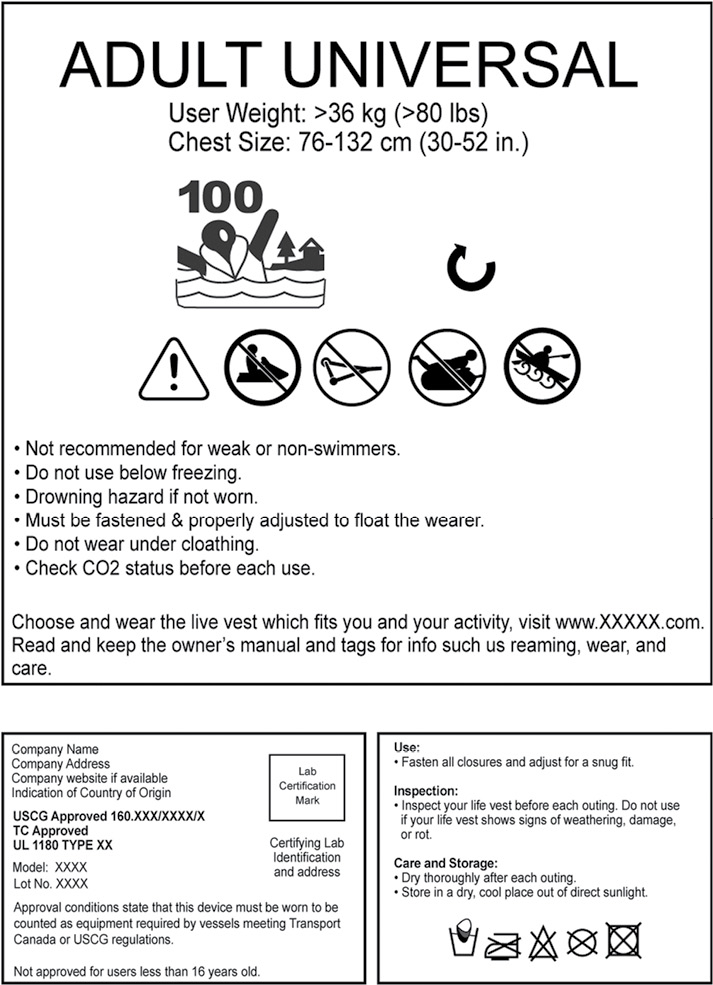
Similar to the old Type I PFD’s, the Level 150 is a high flotation PFD for use in offshore waters and is designed to turn an unconscious person over. The 150N PFD provides a minimum of 15kg of buoyancy per lifejacket and is most found for general use around the coast and offshore waters. A level 150 life jacket will turn a wearer, conscious or not, to a safe position onto their back allowing them to keep their airways clear, reducing the risk of drowning. The performance of the Level 150 PFD may be affected by what the wearer is wearing. For example, if they are wearing heavy clothes or workwear the buoyancy may not be sufficient and therefore the user should wear a higher-performing PFD.
A level 275 PFD provides a minimum of 27.5kg of buoyancy per PFD and is the recommended product for those going into extreme conditions or those wearing heavy PPE clothing, which may adversely affect the buoyancy of the wearer and the self-righting capacity of lesser life jackets. It is designed to ensure that the user is floating in the correct position with their mouth and nose clear of the surface. Therefore, you are most likely to find these used in commercial and offshore industries.
How To Choose the Correct Personal Flotation Device
Today’s life jackets come in a variety of shapes, sizes, colors and materials. No matter which life jacket you choose, be sure it’s right for you, your planned activities and the water conditions you expect to encounter. Before purchasing you should check the manufacturer’s rating for your size and weight and then try it on. If it has zippers and buckles, be certain that they are zipped or buckled properly. Once you have it adjusted lift your arms over your head and have someone pull up on the shoulders. If there is excessive room above the opening and the jacket rides up impeding your chin or face, then it does not fit properly. Snug it up and try again or find a different jacket. It is extremely important that you choose a properly fitting PFD. One that is too big will cause the device to obscure your face and may make breathing difficult, and ones that are too small may not have enough buoyancy to keep you afloat. Before purchasing, check the label for agency approvals and that the jacket is appropriate for your intended activity. One of the items included in the USCG vessel safety check is that there is at least one adult size personal flotation device for each adult person on board the vessel. If children are on board, then the vessel must have one child size personal flotation device for each child under the age of 13.
A Few Reminders:
California law requires children under the age of 13 to wear a USCG–approved life jacket while underway in a boat of any length (unless tethered to a sailboat or in an enclosed cabin).
Inflatable life jackets are acceptable for persons aged 16 and older if they are wearable, activated by both pull and oral inflation features, and USCG–approved. Many of the newer inflatable PFDs do not require that they be worn in order to be counted towards the carriage requirements due to their design, while most of the older products do. Select the PFD that is appropriate for your needs carefully and understand the limitations of the device.
Persons using underwater maneuvering devices (dive boards) are exempt from wearing a life jacket.
All life jackets must be in good and serviceable condition and must be readily accessible. The life jackets must be of the proper size for the intended wearer. Sizing for life jackets is based on body weight and chest size.
All persons must be wearing an approved PFD on vessels under 16 feet in length, or any jet ski, canoe or kayak.
When it comes to PFDs, certification is crucial to ensure the user’s safety. Compliance with the regulations ensures that we are purchasing a device that meets the minimum design standards. All PFDs must be evaluated and tested by a United States Coast Guard recognized laboratory. These labs assess the product, conduct necessary testing then certify compliance. In some cases, they will also perform factory inspections. Resist the temptation to purchase that cheap imported knock off PFD sold on Amazon for $20. You and your families’ safety are more important than saving a few dollars on critical safety equipment.
Until next month I am going to sit back, enjoy a fine port that was a gift from a client and cigar as I inspect my several dozen legacy personal flotation devices. Until then please keep those letters coming. Even the ones where you slam me for my oversights and errors. If you have a good story to tell, I love a good story. If you have good photos of right and wrong, please send them and I will include them in next edition of “is it right or is it wrong”. I can be reached at patcarson@yachtsmanmagazine.com

